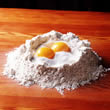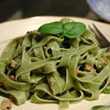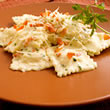Precise step by step instructions in English 8)
Rolling by hand works, too, and can easily be done with just a rolling pin and a large work surface.
Try these recipes for fresh pasta:
Noodle Basics
Fresh pasta contains only three ingredients: flour, salt, and eggs.
- Semolina, a high-protein flour made from Durum wheat, makes better pasta than all-purpose flour. It creates a stronger gluten structure, allowing for more pliable dough.
- Salt provides flavor, and the eggs create richer dough, along with binding the dough together.
- Olive oil is sometimes added for flavor, or, if the pasta is to be dried, water is used instead of eggs.
 |
Mixing
Kneading the dough creates the important gluten structure that holds the pasta together. Using a stand mixer with a dough hook simplifies the process: just add the ingredients and mix. Kneading by hand takes more effort, but is still quite enjoyable (and a good workout).
- Start with a large, clean work surface. Make a mound of the flour and salt with a well in the middle.
- Add the eggs to the well, and start stirring with a fork, slowly incorporating all the flour until the dough comes together.
- Knead the dough until it is soft and pliable. This might take several minutes.
Rolling
A pasta machine is a pasta maker's best friend. Just follow these tips for flawless dough:
- Use the machine for the final kneading. Run the dough through the widest setting on the machine, fold into thirds, and roll again. Continue this process until the dough is shiny and elastic.
- Work the dough through the settings of the machine until the desired thickness is reached.
- Four hands are better than two: enlisting some help with turning the handle of the pasta machine will make this job much easier.
- If you're working with only a portion of the dough at a time, keep the remainder wrapped in plastic to prevent it from drying out.
Rolling by hand works, too, and can easily be done with just a rolling pin and a large work surface.
- Just as with a pasta machine, roll the pasta dough flat, fold into thirds, and roll flat again, until the dough is shiny and elastic.
- Make sure the dough is in small enough batches to be workable. (Slightly smaller than your fist is a good gauge.) Keep extra dough covered in plastic until you're ready to work with it.
- Roll to the final thickness, and form desired shape.
Try these recipes for fresh pasta:
 |
Shaping
Fresh pasta allows you to choose your favorite shape of pasta, in any size you choose.
- Any sort of thin, flat pasta is possible when making pasta by hand, including lasagna, fettuccine, or linguine.
- Complex shapes, such as penne, spaghetti, or macaroni requite special cutters and attachments added to the pasta machine.
- Filled pastas, such as ravioli or tortellini, are perfect for fresh-made pasta. You can fill them with anything you choose, and create the best pairing possible between filling and sauce.

No comments:
Post a Comment